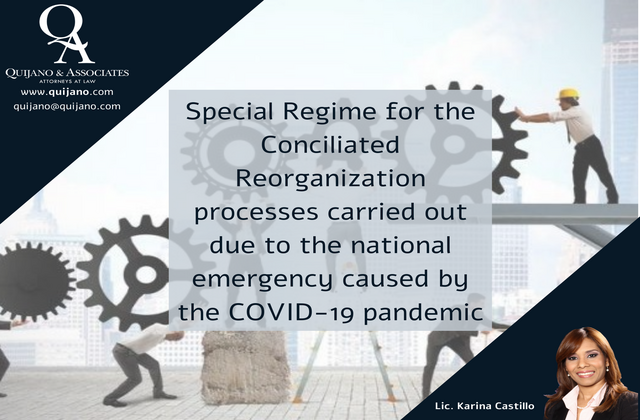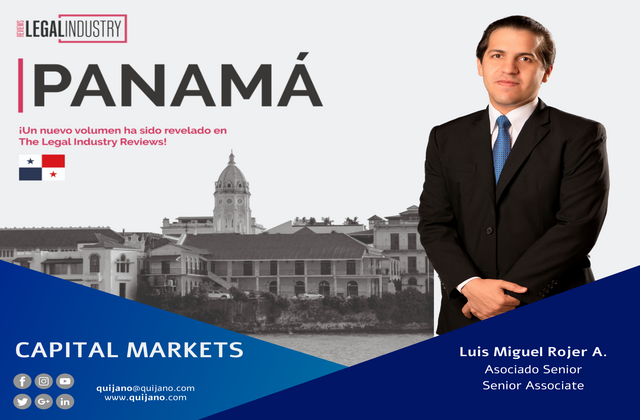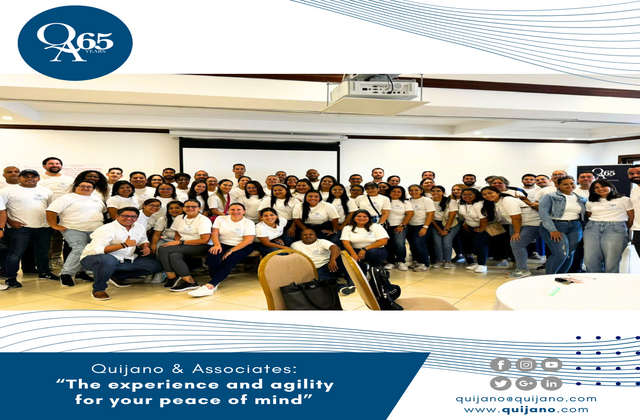Special measures for the Conciliated Reorganization Process established during the National State of Emergency caused by the COVID-19 pandemic

Due to the adverse situations brought about by the Covid-19 pandemic, the economic and business sector has been severely affected and has led to non-compliance of obligations within its operational line of business despite the multiple alternatives established by the National Government and adopted by the business sector in order to minimize the negative impact and consequences arising from the difficult situation that is being experienced worldwide.
This explains the initiative to enact Law 212 of April 29, 2021, which establishes the Special Regime for the Conciliated Reorganization processes to be carried out due to the national emergency caused by the COVID-19 pandemic. On the other hand, this legislation also takes into account that Law No. 12 of the 19th of May, 2016 established the procedures for insolvency and other provisions did not include cases involving force majeure, and the present situation requires short procedures while protecting the credit and the existing jobs.
2. Generalities of the Conciliated Reorganization Law
Law 212 of the 29th of April, 2021 established special provisions for the conciliated reorganization processes in order to protect the credit and the creditors in a situation of insolvency created by the State of National Emergency. It is important to bear in mind that in March 2020 the authorities ordered the closing of commercial establishments of both natural persons and legal entities.
The above-mentioned Reorganization Law determines who may be subject to this law and the pre-existing conditions that must be maintained in order to be subject to the existing regulations as explained below:
Any individual merchant or commercial partnership registered or not registered in the Public Registry with a commercial domicile, branch, agency or establishment in the Republic of Panama may submit to the conciliated reorganization process, provided that the individual or the entity is in a situation of cessation of payment, imminent insolvency or foreseeable lack of liquidity due to the State of National Emergency because of the COVID-19 pandemic, provided that the commercial activity involved has completed a minimum of 24 months of operation and that the notice of intent with a maximum term of two years is properly submitted.
Under the Conciliated Reorganization Law, the following are eligible to file for reorganization:
a. It is optional for the debtor or by the debtor’s representative to request the initiation of the process, but the debtor is bound to appear if the Reorganization has been requested by a Creditors’ Meeting;
b. By a representative of the Creditors’ Meeting.
The conciliated reorganization process shall include an extrajudicial mechanism called conciliation, by means of which the debtor and its creditors may negotiate the company’s Continuity Plan for its reorganization within a period of insolvency financial protection assisted by a certified conciliator.
The law stipulates two types of conciliation, the institutional conciliation when it is carried out in a private arbitration, conciliation and mediation center which may apply the provisions of its regulations regarding the conciliation procedure, administration expenses, personnel fees, and the appointment of the conciliator. Or it may be carried out in an ad hoc or independent conciliation when the parties appoint an independent professional as conciliator.
One of the most relevant characteristics is that the conciliated reorganization process has a duration of six months to be counted as from the publication of the notice of intent.
Stages prior to the beginning of the process:
Before initiating the conciliated reorganization process, the debtor must meet with its main creditors in order to appoint a conciliator by mutual agreement and the desire to formalize the process in question. It is understood that with main creditors are the ones that hold more than 50% of the total liabilities;.
The conciliator referred to above is a person who is appointed to manage the process and shall have the function of facilitator for both parties, so that they can negotiate and approve an agreement including the continuity plan of the company. This conciliator, as required by law, must comply with a series of requirements to be able to act as such and fulfill the functions detailed in articles 14 and 15 of the Conciliated Reorganization Law.
Upon the establishment of these parameters, the debtor shall submit a request to the appointed conciliator, and such request must be accompanied by the documents listed below:
1. An Authenticated Copy of the Minutes of the Shareholders’ Assembly or of another body in the case of a corporation, in which the resolution to avail itself of the Conciliated Reorganization Process is recorded;
2. An explanation of the motives that determine how the measures adopted on the occasion of the COVID-19 pandemic affected its operations financially and led the legal entity to a state of cessation of payment, imminent insolvency, or foreseeable lack of liquidity;
3. Audited financial statements of the last fiscal year, issued by a certified public accountant;
4. Interim financial statements corresponding to the last quarter prior to the date of the application, certified by an authorized public accountant. In the event that the debtor does not have audited Financial Statements, the following may be submitted:
a. Income tax returns filed in the last two fiscal years;
b. A sworn statement by the debtor before a notary public, in which the debtor declares to have accounting books or records and that they have been delivered to an authorized public accountant for the respective review;
c. An opinion or report from an authorized public accountant certifying the following:
i. That the accounting books or records of the company have been reviewed.
ii. That no inconsistencies have been found in the accounting books or records of the company;
iii. That upon the review of the accounting books or records it was established that the company is in a state of cessation of payment, imminent insolvency, or foreseeable lack of liquidity;
iv. An inventory of assets and liabilities as of the last quarter immediately prior to the date of the application, certified by a certified public accountant;
v. A list of the assets, their location and the encumbrances affecting them;
vi. A list or summary of the proceedings pending;
vii. A list of employees or a list of the collaborators, whatever their contractual situation may be in the month prior to the request;
viii. A list of all of the creditors with their respective credits and their contact information.
The debtor shall be entitled to submit a proposal for a Continuity Plan to be shared with the creditors.
Once the conciliator has been appointed and has accepted the position, the conciliator shall have five days to be counted as from the presentation of the request by the debtor to review the documentation provided and validate if it complies with the established requirements in order to proceed with the presentation of the notice of intent that initiates the process.
Beginning the process
The reorganization process begins with the sole filing of the notice of intent before the insolvency judge or the respective civil circuit judge. The filing may be carried out in writing or electronically, provided that a record of the remittance and delivery is established. Such evidence of receipt shall be provided according to the provisions of Article 478 of the Civil Code, which establishes that:
Article 478. All documentation addressed to the court shall bear on the upper margin of the first page the indication of the type of proceeding to which it refers and the name and surname of the parties. Notwithstanding the foregoing, once received by the clerk’s office, its return may not be ordered for lack of the said requirements or for any other defect of a formal nature. When a party wishes to have a record of the date and time of filing, said party has to request it orally and the clerk shall make the corresponding notation, if an extra copy of is submitted to him.
– About the Reorganization Process:
Once the notice of intent is filed, the conciliator shall order the publication of said notice for five (5) consecutive days in mass media in written form including an appeal to all domestic or foreign creditors to appear within a term of ten days. The conciliator shall also send such communication to the creditors using the contact information provided.
Once the term of ten (10) days mentioned above has expired, the conciliator shall summon the debtor and the creditors, so that in the first meeting the appointment of the conciliator is ratified, the continuity plan proposed by the debtor is discussed, if there is such plan, the need for a financial expert who shall prepare or validate the continuity plan for the subsequent review and approval of the parties is confirmed. If it is determined that the participation of the financial expert is required, the appointment of such expert must be approved in said meeting.
Like the conciliator, the regulations have established the functions and the requirements to act as financial expert in the conciliated reorganization processes. Among the functions stipulated in the law, the financial expert shall have a term of five weeks to prepare and propose a continuity plan for the company, and such plan must contain:
1. An analysis of the financial situation of the business;
2. An analysis of the historical situation of the business;
3. The impact that COVID-19 and the declaration of the state of national emergency had on the company’s financial results;
4. Cash flow projections for the following five years;
5. The structure proposed for repayment of the financial obligations, according to the company’s actual capability;
It is important to mention that the continuity plan must contemplate all the provisions regarding the rights of the creditors and the privileges established in the Civil Code for the credits that enjoy preference, to be included in the order of priority the debts contracted for the survival of the company and the debts originated by the ordinary operation of the company.
The notifications or communications within the conciliated reorganization process shall be considered valid when they are sent to the e-mail address provided by the parties and the call for the conciliation meetings must be made at least three (3) days prior to the date scheduled for the respective meeting. It is also contemplated that hearings, meetings and a meeting of creditors may be held virtually, leaving a record of the development of the meeting and the documentation used to do so may be digital, provided that each of the parties declare under oath the legitimacy of the documentation provided and what arises from the process.
By operation of law, the filing of the notice of intent prevents the initiation of other reorganization or liquidation processes such as the bankruptcy financial protection for a maximum period of six months, , is that by operation of law it prevents the initiation of other reorganization or liquidation processes such as the bankruptcy financial protection for a maximum period of six months, to be counted as from the date of publication of said notice of intent referred to in Article 12 of Law 212 of the 29th of April, 2021.
As a result of the bankruptcy financial protection, the foreclosure proceedings that have begun before the beginning of the Conciliated Reorganization Process must be submitted to the Judge in order to be incorporated in said Process so that those credits are also considered as well as the precautionary measures, and the judge may determine if they are still in force or not.
In those cases, in which exceptions have been filed and a decision is pending, they shall be processed as objections to the credit. As for the processes of security, real or fiduciary, as long as the protection referred to is in force, no process for the execution of such security may be initiated. Any processes initiated shall be suspended if the auction has not been carried out.
However, creditors are given the possibility of appealing to the judge by means of a substantiated request, so that the judge may authorize the initiation or continuity of the proceedings, provided that the execution does not affect the operation of the company or the viability of the Continuity Plan.
-Ratification of the Continuity Plan.
For the ratification of the continuity plan it is required that it be approved by the debtor and by the absolute majority of the creditors representing 51% of the totality of the liabilities. Once the conciliation agreement is signed, it binds the debtor and all its creditors either present or not present when the conciliation was approved.
Termination of the Conciliated Reorganization process and its effects.
The conciliation proceeding shall conclude:
1. Upon the signature of a Conciliation Agreement approving the Continuity Plan;
2. Upon the failure to approve of a Continuity Plan;
3. Upon the withdrawal of the debtor or the withdrawal approved by decision of the Creditors’ Meeting;
4. Upon the debtor’s unjustified failure to attend two scheduled meetings, which shall be considered as lack of interest in the solution of the controversies;
5. Due to the debtor’s incapacity.
When the parties have not reached an agreement as to the approval of the Continuity Plan, the conciliator shall issue a Minutes stating the lack of agreement and the conciliatory procedure is concluded, and the conciliator shall have to issue a certificate attaching a copy of said Minutes to be sent to the judge to close the file. If this is the case, it is determined that the debtor shall not be able to initiate the Reorganization Bankruptcy Process established in Law 12 of 2016 either subsequently or simultaneously.
3. Conclusions
By means of the Conciliated Reorganization Law 212 of April 29, 2021, the Special Regime for the Conciliated Reorganization Processes was established due to the State of National Emergency due to the COVID-19 pandemic.
Any individual or legal entity in a situation of cessation of payment, imminent insolvency, or foreseeable lack of liquidity may submit to the conciliated reorganization process.
The reorganization may be initiated or requested by (i) the debtor or the debtor’s representative, or (ii) by the representative of the debtor’s creditors duly organized as a Creditors’ General Meeting;
The reorganization process begins upon the filing of the notice of intent;
The debtor, the creditors and the conciliator actively participate in the process, and may require the assistance of a financial expert;
The duration of the conciliated reorganization process is two (2) years;
For the conciliated reorganization agreement to be approved, it has to be approved by the debtor and the absolute majority of the creditors representing at least 51% of the totality of the liabilities.
The Insolvency Law does not contemplate any differentiation among creditors on the basis of nationality.
The conciliation procedure shall be concluded:
1. Upon the signature of a Conciliation Agreement approving the Continuity Plan;
2. Upon the failure to approve a Continuity Plan;
3. Upon the debtor’s withdrawal or the approval of such withdrawal by a decision of the Creditors’ Meeting;
4. Upon the debtor’s unjustified failure to attend two scheduled meetings, which shall be considered as the debtor’s lack of interest in the solution of the controversies;
5. Due to the debtor’s incapacity.




